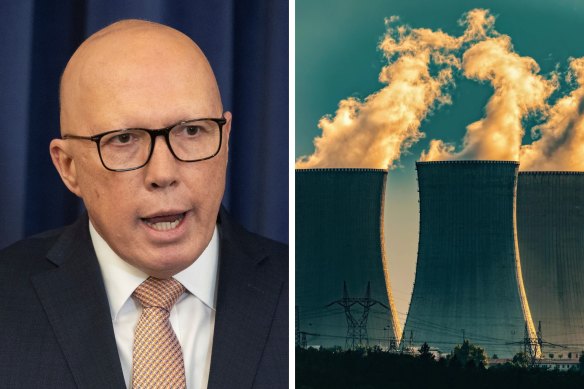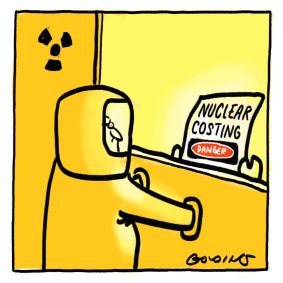By Mike Foley and Nick Toscano
Power bills would rise by about $665 per year to repay the cost of building seven nuclear plants under Opposition Leader Peter Dutton’s energy plan, new modelling has found, challenging the Coalition to reveal the costings of its signature policy.
Australia’s electricity grid operators have warned that nuclear is a “comparatively expensive” power source that would take at least 16 years to deploy. The analysis, released on Friday by US non-profit think tank the Institute for Energy Economics and Financial Analysis, is the first that quantifies how much it could cost people to pay for the opposition’s nuclear power ambitions.

Opposition Leader Peter Dutton has committed to build seven nuclear plants across the country if he wins the next election. Credit: Alex Ellinghausen, Getty Images
The institute took actual construction costs of nuclear plants recently completed or still underway in countries comparable to Australia, and calculated how much it would cost electricity customers to repay this based on current electricity bills and in today’s dollars.
It then assumed the plants would need to make a 6 per cent margin to pay back bank lenders and equity investors over 60 years, the lifespan of nuclear plants listed by their makers. CSIRO lists this as a standard arrangement for all energy generators in Australia’s electricity market such as batteries, wind farms and so on.
The institute then added these loan repayments and investor margins to the costs of electricity generation from a nuclear reactor to show how much a plant would charge an Australian customer for power supply.
The opposition plans to build seven nuclear plants on the sites of existing coal plants, including two small modular reactors and five traditional large-scale plants, with the first to be operational by 2037. These coal plants currently generate about 11 gigawatts of power.
Coalition energy spokesman Ted O’Brien said the report was “shallow and flawed” and that the opposition would release its costs before the federal election, due by May.
“We have all seen tricks like this before where a dodgy piece of analysis cherry-picks the worst-case scenario projects and pretends that it’s common practice,” O’Brien said.
The report’s costings are based on the bills for construction of large-scale nuclear plants in nations with comparable economies to Australia – the US, UK, France, Finland and Czech Republic – and the forecast costs of small modular reactors, which are not yet in commercial operation.
To arrive at its price estimate of $665 per household each year, the institute took the average of construction costs from these countries’ recent reactor builds.
It excluded cheaper nuclear plants in the United Arab Emirates, where the authoritarian regime recently built reactors using migrant workers from Bangladesh and Pakistan.
Cheaper builds in South Korea were also excluded, although the north Asian economic powerhouse has kicked off 11 nuclear projects since 2005 and completed 20 before 2005. The report noted that South Korea’s nuclear construction company was unable to replicate the low costs overseas, such as two reactors it was contracted to build in the Czech Republic.
It said household energy bills could rise between $450 and $1154 in NSW and Victoria based on current energy bills in those states. This figure is based on the electricity use of a medium household. Bigger families would pay more.

Credit: Matt Golding
Based solely on data from the US, where the cheapest nuclear plants were built, power prices would rise about $450.
Shadow treasurer Angus Taylor told the Press Club in May that the nuclear plants the opposition plans to build would be commercially viable and not publicly subsidised.
However, O’Brien has said nuclear plants would be built by a government-owned entity, like Snowy Hydro.
If the opposition chose this model of public funding, the construction costs would add to national gross debt and incur interest on the repayments for loans that would be taken out to fund construction.
The CSIRO’s GenCost report on electricity generation, released in May and produced in collaboration with the Australian Energy Market Operator, said renewable energy delivers cheaper power than nuclear plants.
The institute’s Australian electricity analyst Johanna Bowyer said the cost of building nuclear plants typically blew out around the world, ranging from 1.7 to 3.4 times the original price. The UK’s Hinkley Point C plant, which was announced in 2007 at a cost of $18 billion, is now set to be completed 13 years late at a cost of $90 billion.
“The cost of electricity generated from nuclear plants would likely be 1.5 to 3.8 times the current cost of electricity generation in Eastern Australia,” Bowyer said.
Cut through the noise of federal politics with news, views and expert analysis. Subscribers can sign up to our weekly Inside Politics newsletter.